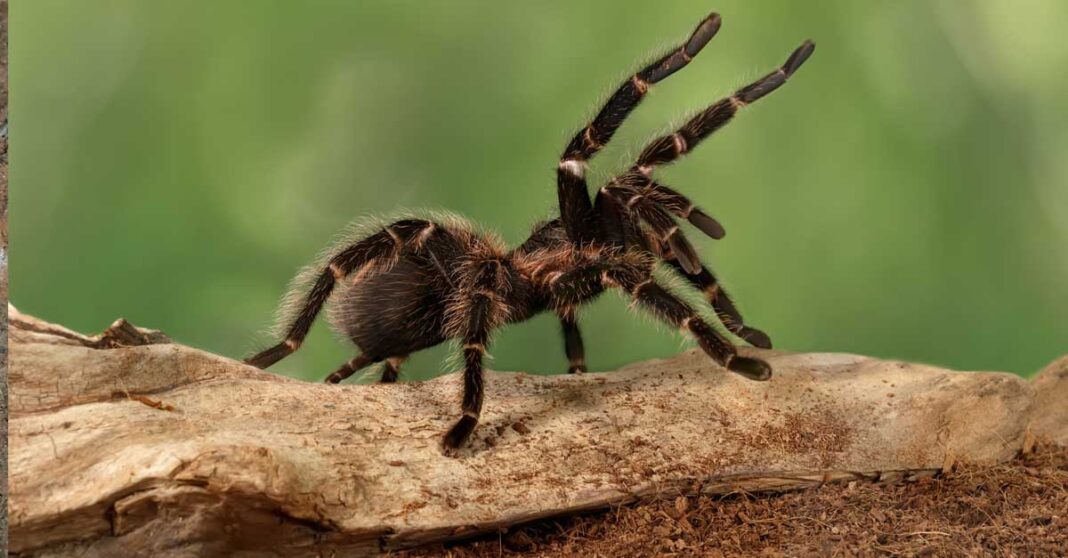Decorations of realistic spiders or webs hanging from the ceiling make the house feel spookier on Halloween, but the spiders on this list will surprise you with their giant body sizes and unique characteristics. Hopefully, they don’t creep up behind you!
Spiders, famously known for their spooky eight walking legs and tiny eight eyes, ambush in a quiet, undisturbed, moist environment where they can catch and consume prey on their web, as some spiders may be poisonous or harmless. To celebrate “World Save a Spider Day” on March 14, here are the top ten largest spiders from Laos and around the world listed by BBC Science Focus.
10. Sand-dwelling Huntsman Spider – Cerbalus aravaensis
This spider resides in the southern dunes of Israel and Jordan, where it is nocturnal and active during the summer. An adult huntsman spider has 14 cm-long legs – with a 15-centimeter ruler, you can imagine his leg length.

9. Brazilian Wandering Spider – Phoneutria fera
This highly venomous spider originates from South America and lives in vegetation, but moves around the ground when it grows up with noticeably long legs of 15 centimeters.

8. Camel Spider – Solifugae
The camel spider, also known as the wind scorpion and sun spider, is rarely considered a spider or a scorpion because it does not produce spider webs and, unlike most scorpions, has an erected tail. However, its legs can reach 15 centimeters in length.

7. Colombian Giant Redleg Tarantula – Megaphobema robustum
The redleg spider has a dark black spot on its dorsal section and a pale orange color. As spiders mature, they tend to develop more furry hair around their legs and bodies. Redleg spiders consume small insects and mice in South American rainforests. Despite having 16-centimeter-long legs, they are timid and defensive by nature.

6. Face-sized tarantula – Poecilotheria rajaei
With a leg span of up to 20 centimeters, these hairy tarantula spiders are commonly found in tropical regions and may terrify any nearby predators or humans. The spiders themselves do not hunt with a web, but instead, use it as a building material. They produce strong venom to slay reptile animals.

5. Chaco Golden-knee Tarantula – Grammostola pulchripes
The beauty of this golden knee tarantula is highlighted by its golden knee markings. This spider’s legs are 17 to 20 centimeters long and consist of several fangs. Golden knee tarantulas are sometimes kept as exotic pets because of their calm personality.

4. Brazilian Giant Tawny red tarantula – Grammostola anthracina
This spider was first described in the year 1842 by Carl Ludwig Koch, a German entomologist, and arachnologist. The spider dwells in large areas of South America and the giant tawny tarantula is believed to live up to 20 years with a leg span of 23 centimeters.

3. Brazilian Bird-eating Tarantula – Lasiodora parahybana
When provoked, this species will bite, despite being popular as a pet and harmless to humans. Their legs are up to 28 centimeters, and male spiders have longer legs than female spiders.

2. Goliath Bird-eating Tarantula – Theraphosa blondi
This spider does not hunt or feed on birds, despite its name, but its legs can grow up to 28 centimeters in length. Surprisingly, unlike most other species, female spiders do not consume male spiders during mating.

1. Giant Huntsman Spider – Heteropoda maxima
The largest spider (going by leg length) lives in Laos! The giant huntsman spider has a leg span of up to 30 centimeters. The spider was first described in 2001 by Peter Jäger after being discovered in a cave in Laos.

Giant huntsman spider – Heteropoda maxima in a cave. ( Photo: iStock)./



